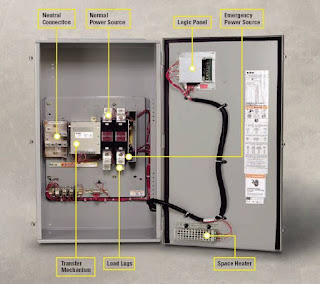Why Transformer Rated In kVA, Not in KW?
Why Transformer Rated In kVA, Not in KW?
Transformer Always Rated In kVA instead of KW
As the name suggest, transformer only transfer the power from one circuit to another without changing the value of power and frequency. In other words, It can only step up or step down the value of current and voltage while the power and frequency would remain same. A general date on transformer nameplate are printed for further details, such as rating in VA, single phase / three phase (power or distribution transformer), step up / step down, connection etc.
Right to the question, In simple words,
There are two type of losses in a transformer;
- 1) Copper Losses
- 2) Iron Losses or Core Losses or Insulation Losses
Copper losses (I²R) depends on current which passing through transformer winding while Iron losses or core losses or Insulation losses depends on Voltage. i.e. total losses depends on voltage (V) and current (I) which expressed in Volt ampere (VA) and not on the load power factor (p.f). That’s why the transformer rating may be expressed in VA or kVA, not in W or kW.
Let’s explain in more details to get the idea that why a transformer rated in VA instead of kW?
When manufactures design a transformer, they have no idea which kind of load will be connected to the transformer. The load may be resistive (R), inductive (L), capacitve (C) or mixed load (R, L and C). Its mean, there would be different power factor (p.f) at the secondary (load) side on different kind of connected loads depends on R, L and C. This way, they go for VA instead of W in case of Transformer.
Lets clear the rating of transformer in VA instead of W with solved example.
Losses of transformer will remain same as long as the magnitude of current / voltage is same. No matter what power factor of the load current / voltage is.
Example:
Suppose for a single phase step up transformer
- Transformer rating in kVA = 11kVA
- Primary Voltages = 110V
- Primary Current = 100 A
- Secondary Voltages = 220V
- Secondary Current = 50 A.
- Equivalent resistant on Secondary = 5Ω
- Iron losses = 30W
In first scenario, If we connect a resistive load to the secondary of the transformer at unity power factor θ = 1,
Then total losses of transformer would be copper losses + iron losses, i.e.
I²R + Iron losses
Putting the values,
(502 x 5 ) + 30W = 12.53kW
i.e. losses on primary and secondary of transfer is still same. (See below example for secondary losses as well)
The transformer output will be:
P = V x I x Cos θ
Again putting the value from secondary (Same value if we put the values from primary)
P = 220 x 50 x 1 = 11kW.
Now rating of transformer
kVA = VA / 1000
kVA = 220 x 50 / 1000 = 11kVA.
Pow, In second scenario, connect a capacitive or inductive load to the secondary of the transformer at power factor θ = 0.6.
Again, total losses of transformer would be copper losses + iron losses, i.e.
I²R + Iron losses
Putting the values,
(502 x 5 ) + 30W = 12.53kW
Hence proved that losses in both of primary and secondary is same.
But The transformer output will be:
P = V x I x Cos θ
Again putting the value from secondary (Same value if we put the values from primary)
P = 220 x 50 x 0.6 = 6.6kW.
Now rating of transformer
kVA = VA / 1000
kVA = 220 x 50 / 1000 = 11kVA.
Its mean, 11kVA transformer rating means it can handle of 11kVA. It is our turn to transform and utilize the 11kVA as 11kW (we can do it by improving the power factor to 1 in case of pure resistive load) which is not predictable and even very hard to get in case of inductive and capacitive loads where power factor would have different values.
From the above example, it is clear that the rating of transformer is same (11kVA) but different output in power (11kW and 6.6kW) due to different power factor values after connecting different kind of load which is not predictable for transformer manufactures where the losses are same in both cases.
So these are the exact reason for transformer rating in kVA instead of kWA.
- Good to know:
As like transformer, rating and capacity of Alternators/generators, Stabilizers, UPS, Transmission lines are also rated in VA instead if W While power plant capacity, AC (Air condition) and motors are rated in W (watts) rather than VA (Volt-Amperes).





Comments
Post a Comment